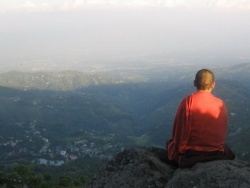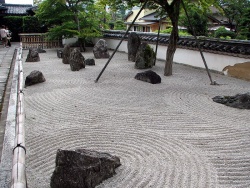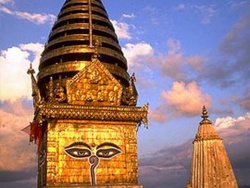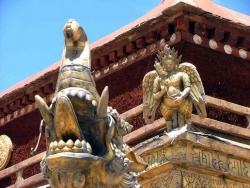The Unborn Dharma
At the I AM (realization of luminosity but inherent and dualistic) and substantial nondual (nondual but inherent) level, unborn is understood in terms of an unchanging, inherent, birthless and deathless awareness. At this point, we discover ourselves as an all-pervading presence not bounded by the birth and death of this body-mind. As an analogy, you used to think you are one of the wave arising and subsiding in the ocean, but now you realize you are the whole ocean. Or you used to think you are the drop of water, until that drop of water sinks into the ocean and you can no longer find a separate identity or drop of water apart from the entire ocean. Or the outbreathe merges with the air in the environment, the air in the vase becomes inseparable from the air of the whole world when the vase breaks. These analogies should give you a sense of the 'all-pervadingness' of Pure Presence, and how 'deathlessness' is experienced when the sense of 'individuality' is overcome in the discovery of one's true identity as this all-pervading Presence. At this level of insight, the transience (the birth and death of waves on the ocean) in contrast is understood to be illusory, unlike the real, absolute unchanging awareness (the deathless oceanic Presence)... it should be understood that the lack of individual identity in the all-pervading Presence is not to be understood as the no-self of Anatta which will be explained further on.
Even though it might be understood that the unchanging awareness is inseperable from illusory, transient experiences (nonduality of subject and object). This is understanding unborn from an inherent (albeit nondual) perspective. This is also the understanding of advaita vedanta (though a common understanding among some zennists, shentongpas, etc). This is understanding things from the substantialist non-dual point of view.
Second is unborn from the perspective of anatta... Due to the insight of anatta it is seen that there is no inherent self anywhere, no subject, no substantiality to any phenomena including a superawareness of sorts... Seeing is the seen, scenery sees! Awareness is realized to simply be a label collating the various transient experiences in the same way that the word weather is a label collating the various diverse, dynamic and ungraspable manifestations like clouds, rain, lightning, wind, etc. Similarly awareness is not an unchanging essence located anywhere but is simply the self-luminous transient manifestations.
So how is this anatta linked to unborn if there is no unchanging awareness? It is the absence of a self at the center that links and persists throughout experience - walking from point A to point Z, there is no sense that there is a self unchanged throughout point A to point Z - instead, experiences are experienced as disjoint, unsupported, self-releasing and spontaneous. In other words, point A is point A complete in itself, same goes to point B, C, to Z.
Do take note that experience is effortlessly and implicitly non-dual, just a refinement of 'view' after this new found experience and realization. That is, from this implicitly and effortlessly non-dual experience and without having the need to reify and rely on a 'source', how is 'unborn' understood?
If we keep on penetrating this, it will come a time that 'boom' we suddenly realized that why is there a need to do so? Why is the relying of the Source so persistent? It is because we have relied on a wrong view despite the right experience.
Once the willingness to let go of the 'wrong dualistic and inherent view' arose, it suddenly it became clear that all along I am still unknowingly relying on 'wrong view'. For example, seeing the same 'mind' being transformed into the transience manifestation.
In actuality there is in seeing just the seen, no seer, in hearing just sounds, no hearer. How is this deathless if there is just manifestation? Just as Zen Master Dogen puts it: firewood does not turn into ashes, firewood abides in the phenomenal expression of firewood while ash abides in the phenomenal expression of ash, while at the same time ash contains firewood, firewood contains ash (all is the manifestation of the interdependent universe as if the entire universe is coming together to give rise to this experience and thus all is contained in one single expression).
The similar principle applies not just to firewood and ash but to everything else: for example you do not say summer turns into autumn and autumn turns into winter - summer is summer, autumn is autumn, distinct and complete in itself yet each instance of existence time contains the past, present and future in it. So the same applies to birth and death - birth does not turn into death as birth is the phenomenal expression of birth and death is the phenomenal expression of death - they are interdependent yet disjoint, unsupported, complete. Accordingly, birth is no-birth and death is no-death... Since each moment is not really a starting point or ending point for a entity - without the illusion and reference of a self-entity - every moment is simply a complete manifestation of itself. And every manifestation does not leave traces: they are disjoint, unsupported and self-releases upon inception. This wasn't dogen's exact words but I think the gist is there, you should read dogen's genjokoan which I posted in my blog.
Lastly is understanding the unborn dharma from the perspective of shunyata. This perspective should complement with the perspective of anatta for true deep experiential insight (without realization of anatta, there will still be clinging to a base, ground, somewhere).
I should say the realization of the unborn dharma (from shunyata) arose the day after you sent me this PM - the details of which can be found in the last ten to twenty pages of my ebook - new materials just added on sunday, in a new chapter called "shunyata". The realization arose spontaneously while simultaneously reading and contemplating an article from a highly experienced mahamudra practitioner/blogger, Chodpa, owner of the blog luminous emptiness.
The realization of unborn from the perspective of emptiness is the realization that everything experienced - thoughts and sensate perceptions are utterly unlocatable, ungraspable, empty. In investigation where did thought arise from, where is thought currently located, and where will thought go to, it is discovered that thoughts are indeed like a magician's trick! No source can be located, no destination can be found, and the thought is located nowhere at all - it is unfindable, ungraspable... Yet "it" magically and vividly appears! Out of nowhere, in nowhere, to nowhere, dependently originated and empty... A magical apparition appears, vividly luminously yet empty. When this is seen, there is an amazement, wonder, and great bliss arising out of direct cognition of the magic of empty luminosity. So how is this linked to unborn? It is realized that everything is literally an appearance, a display, a function, and this display is nowhere inherent or located anywhere - so like a dream, like a tv show, characters of the show may vividly appear to suffer birth and death and yet we know it is simply a show - it's undeniably there (vividly appearing) yet it's not really there. It has no actual birth, death, place of origin, place of abidance, place of destination, ground, core, substance.
However in the insight of emptiness, this is different from substantial nonduality as there is no referencing of the manifestations and appearances as being part of an unchanging awareness. Awareness is the unborn display - not the display is appearing in/as an unborn, unchanging Awareness. This is the difference between unborn understood from a nondual and noninherent view, and unborn understood from a nondual but inherent view. Even though it is realised all is mind/experience, there is no substance to mind/experience. It is not the same as the subsuming of all experiences to a "one mind" like substantial nondualism. There is also no cosmic mind (this is actually a nonbuddhist view) but individual, unique and nondual mindstreams.
Lastly if you are interested in dzogchen (oh and just wondering, are you more into mahamudra or dzogchen?) you might want to chat with loppon namdrol in dharmawheel (vajrahridaya informed me that namdrol has recently started posting in that forum, previously namdrol posted mostly in esangha before it was taken down), namdrol is very knowledgeable, has realization of emptiness and is an experienced dzogchen practitioner under chogyal namkhai norbu rinpoche. He is a loppon which means he has like a phd in buddhism, and if memory serves he was asked by a lama to teach dzogchen though he rejected it.
Finally just a note, whenever there is any mentions of permanence, it is not a permanent metaphysical essence of awareness or substance... But emptiness (the absence of inherent existence) is the permanent nature of everything.
Also, as Loppon Namdrol pointed out, Mahaparinirvana sutra and other teachings on Tathagatagarbha on permanence, self etc shld be understood in terms of Emptiness and No-self - it is simply the subversion of Hindu concepts of atman and brahman into emptiness and noself - the true essence is lack of essence. And as Lankavatara sutra points out, the teachings of true self by Buddha is not the same as non-Buddhist teachings of an all-pervasive creator and Self but is simply a skillful means to lead those who fear emptiness to the profound prajna wisdom. It (true self, tathagatagarbha, etc) is not meant to be taken literally as pointing to an inherently existing metaphysical essence. It is a teaching device.



